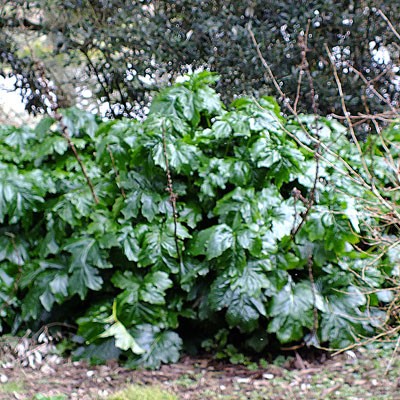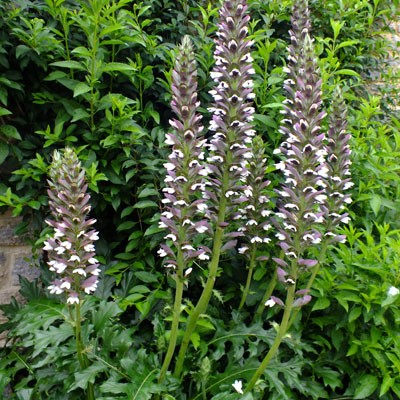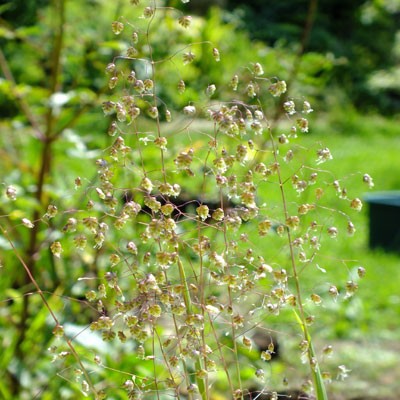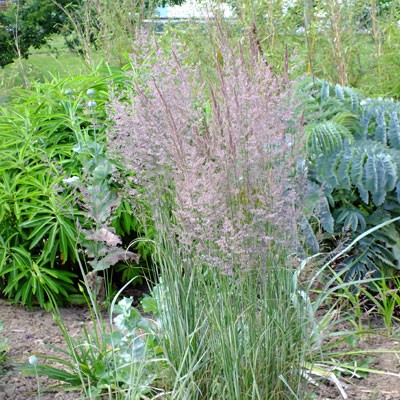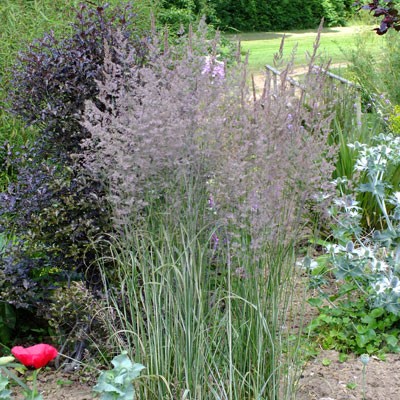-
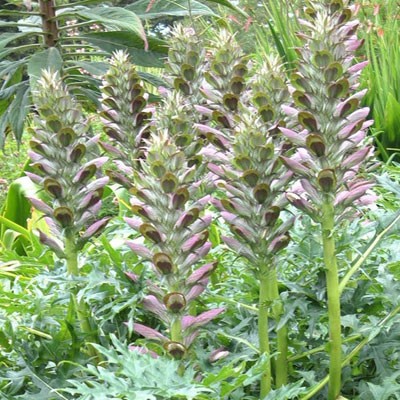
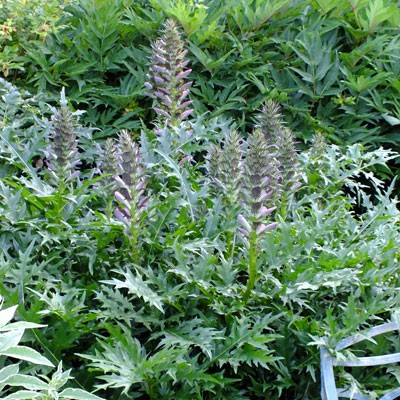
Potsize - 1L
(Acanthus caroli-alexandri) . Handsome plants with large shining ornamental foliage. This species has deeply divided glossy dark green leaves. Spires of hooded foxglove-like flowers in a two-toned purple and white. Height 4-5 feet. The foliage of Acanthus spinosus represents a midpoint between the less divided of Acanthus mollis and the extreme of spikiness, Acanthus spinosus Spinossissimus Group.Links
Acanthus Compared
Botanical Style Photographs
-
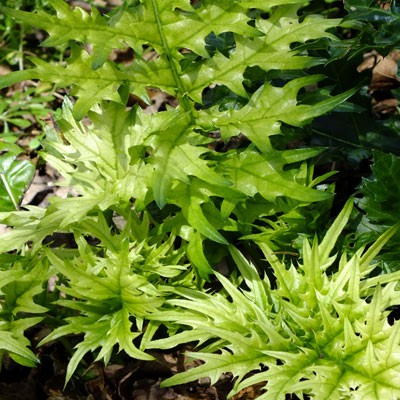
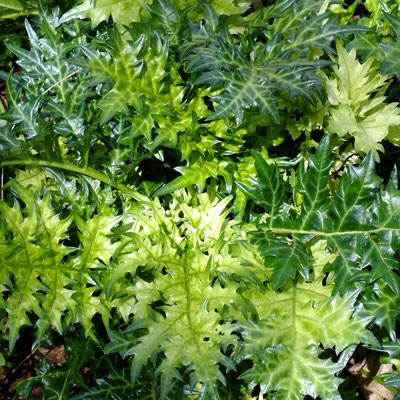
Potsize - 1L
Acanthus spinosus 'Lady Moore'. Handsome plants with large shining ornamental foliage. This species has deeply divided glossy dark green leaves, which in 'Lady Moore' are splashed and spotted cream in Spring when the plant is growing vigorously. Spires of hooded foxglove-like flowers. Height 4-5 feet. the cream variegation does not show up in potted plants.Links
Acanthus Compared
Botanical Style Photographs
-

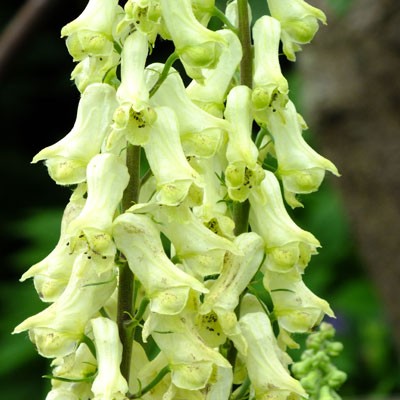
Potsize - 1L
Aconitum lycoctonum ssp. neapolitanum (lamarckii). WOLFSBANE. Tall stems with dense pyramids of narrow hooded flowers crowded higgledy-piggledy up the stem, each shaded ivory and green. Leaves are more palmate like a delphinium and less cut than other species. A real treasure for part shade. 5ft CAUTION - ALL PARTS OF THIS PLANT ARE POISONOUS Discount of 25p per plant for quantities of 3 or overLinks
Aconite Varieties Compared
Botanical Style Photographs
-
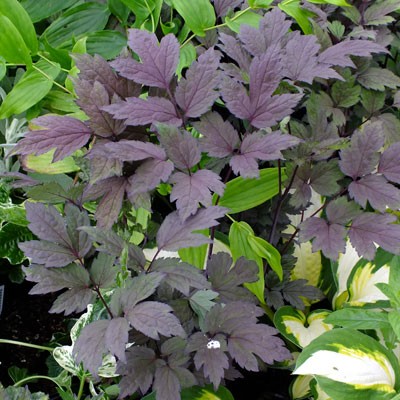
Potsize - 1L
Extremely handsome plant of great distinction with its deeply divided rich purple black leaves and tall waving wand of pink budded white flowers produced as late as Oct. Dark colour becomes more apparent on older plants. Best with moist soil. No need to stake. Immune to slugsLinks
Actaea Compared
-
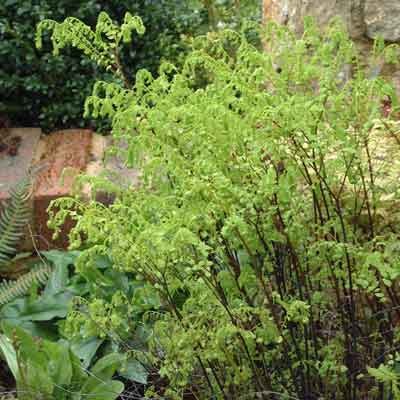
Potsize - 1L
Adiantum aleuticum 'Imbricatum'. Hardy Maidenhair Fern. A delicate little gem with fine fronds branched like the fingers of a splayed hand making a rich lacy tapestry on wiry black stems. 30-40cm. Best in a moist soil in partial shade. Fully deciduous. Plant where there is adequate air flow to prevent humid condition. Delicate in appearance, but bone hardy, coming from the far north west of American across to Japan. Like subsp. aleuticum, but shorter and more upright.Links
Ferns - Garden Pictures
Ferns for Moist Sites
Ferns for Dry Sites
Ferns - Deciduous or Evergreen
Botanical Style Photographs
-
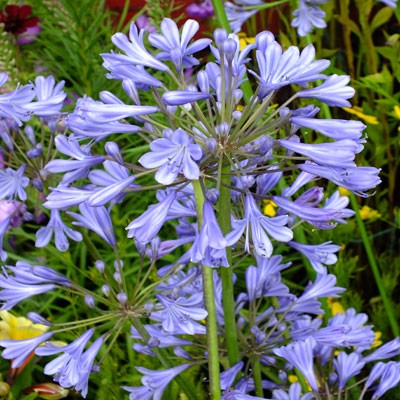

Potsize - 1L
Agapanthus 'Blue Umbrella'. Tall (140cm) strong stems with large spherical heads crammed with rich cobalt-blue flowers. They are a beautiful sight to behold in full flower in Summer and have become particular favourites for larger pots in the English Country Garden. They have handsome dark green, broad strap-like evergreen leaves which can form impenetrable ground cover in milder Counties. Their evergreen nature makes them less robust in cold Winters and in pots they are best brought under cover (no heat is required, just hard frost protection). Flowers June-August. A. praecox subsp. Orientalis, A. africanus, A. umbellatus Discount of 25p per plant for quantities of 3 or overLinks
Agapanthus Compared
-
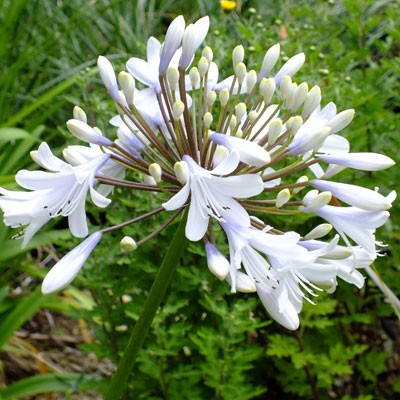

Potsize - 1L
Agapanthus 'Enigma'. The first bicolour agapanthus to be bred in the UK by Ken Rigney. This lovely Agapanthus is neither blue nor white but a beautiful combination of both. Lots of trumpet shaped flowers are borne by reddish bronze pedicels and from white buds become more and more stained at the bases with purple-blue. When fully open the insides and main section of the petals are pure white but the tube and a stripe on the reverse of the petals is violet. The white stamens are tipped with dark anthers. Altogether something really different and a real eye-catcher. 75cm. July-August. EvergreenLinks
Agapanthus Compared
-
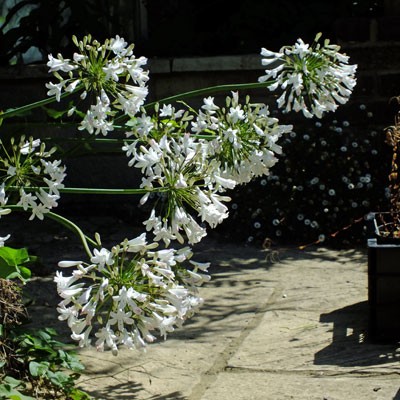
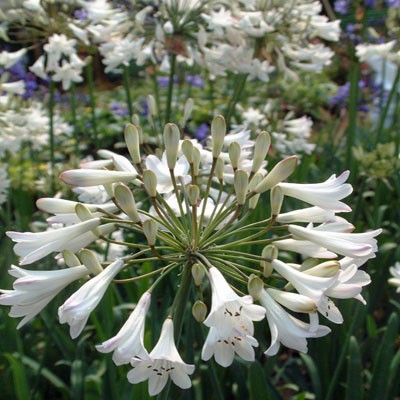
Potsize - 1L
Agapanthus 'Glacier Stream'. Produces a profusion of soft white flowers from green buds. Each flower is tinted slightly purple outside and has a subtle purple stripe. The anthers are grey and the flower stems are flushed purple, making a soft dusky white effect which sits more comfortably in some schemes than a bright white. One of the earliest to flower, blooming from July - August on relaxed, gently arching stems. deciduous and very hardy. 45cmLinks
Agapanthus Compared
-
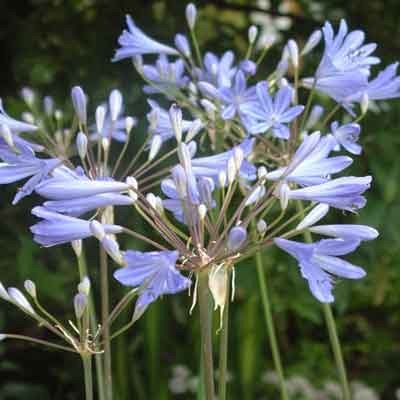
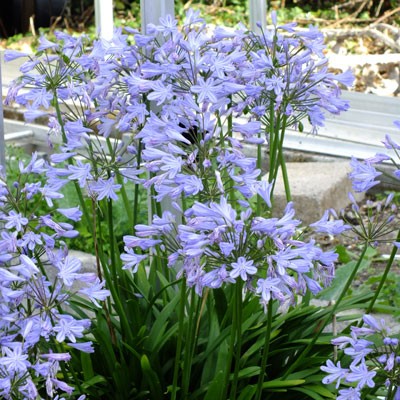
Potsize - 1L
Agapanthus 'Peter Pan' is a new evergreen compact Agapanthus with a dwarf habit. Makes a good clump of leaves to 15cm and in July to September sends up many stems 30-45cm high with open umbels of pale sky-blue flowers each petal enhanced by a darker blue stripe. Hardy in a sunny well drained position Discount of 25p per plant for quantities of 3 or overLinks
Agapanthus Compared
-
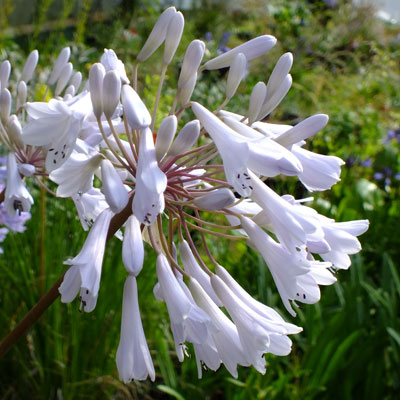
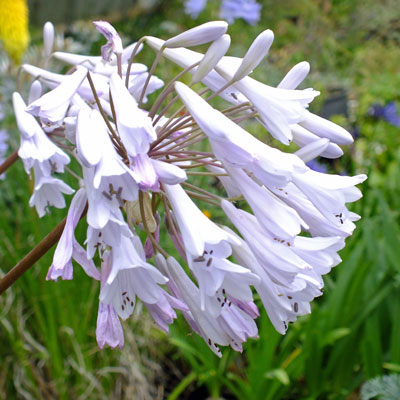
Potsize - 1L
This is an old variety with a very good heritage. It was selected by Lewis Palmer, the breeder of the Headbourne range of Agapanthus. It is a strong growing variety with a distinctive pale pinkish grey-purple flower colour. The stems are brown and the pedicels ruddy. Despite having a broad leaf, usually indicating a degree of tenderness, this variety has proved to be relatively hardy, especially with leaf cover.Links
Agapanthus Compared
-
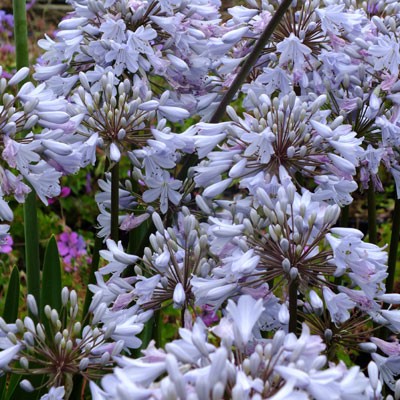
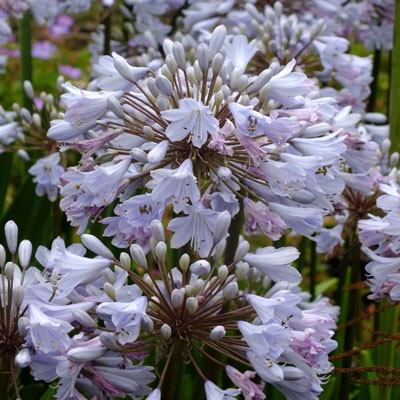
Potsize - 1L
A very refined looking variety with more than a nod towards A.'Windsor Grey'. It is fairly short in flower at around 45cm with well shaped flower heads, each carrying flowers of a pale powder blue wash, striped in a diffuse cobalt. The green of the buds and red stain to the flower stalks creates a very classy looking flower.Links
Agapanthus Compared
-

Potsize - 1L
A variety with particularly large dense heads of purest white flowers. Exceptionally large heads with up to 80 blooms per head. 100cm tall, EvergreenLinks
Agapanthus Compared
-
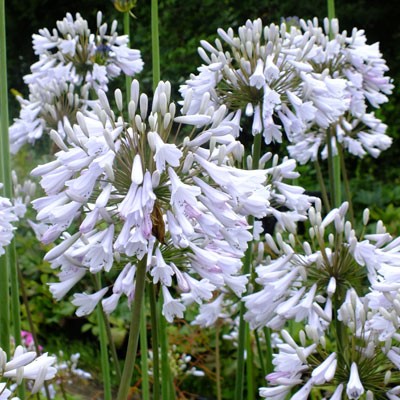
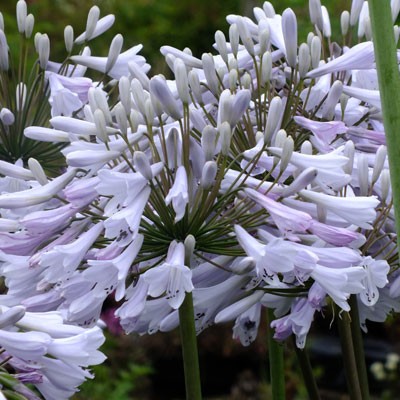
Potsize - 1L
Agapanthus 'Windsor Grey'. A subtle and very beautiful cultivar which is very easy to grow. Flower heads are large and dense with distinctly trumpet shaped flowers that point down at an angle. The colour is softest lilac, fading to pink as the flower ages. 85cm, Late Summer. Deciduous and very toughLinks
Agapanthus Compared
-

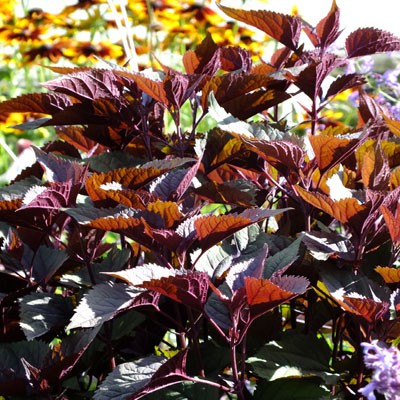
Potsize - 1L
Ageratina altissima 'Chocolate' ( Eupatorium 'Chocolate' ). A useful plant in many respects, growing in a wide range of soils, providing there is moisture. Richly coloured leaves are an attraction throughout the season, whilst the fluffy white flowers, produced late in the summer are a magnet for bees and butterflies. 100cm. Looks particularly fine with the pastel blues of Nepeta and EryngiumDiscount of 25p per plant for quantities of 3 or overLinks
High and Mighty
Botanical Style Photographs
-
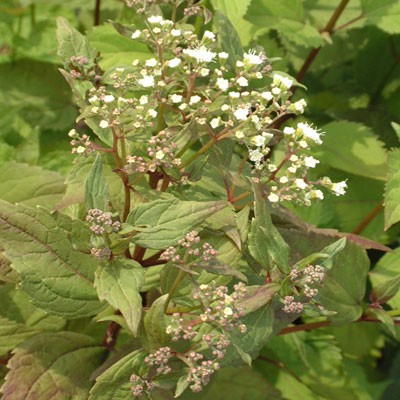

Potsize - 1L
Not a big blousy primadonna, but nevertheless a useful plant full of its own charms. Useful as it is late flowering with compact heads of small white snowballs which are just full of nectar. The leaves are fresh apple green with stems that will colour up mahogany if the plant is in sun. Tones in well with other plants and a good clean colour for a white scheme. Equally at home in the border of wild garden. 100-150cmDiscount of 25p per plant for quantities of 3 or overLinks
High and Mighty
Botanical Style Photographs
-
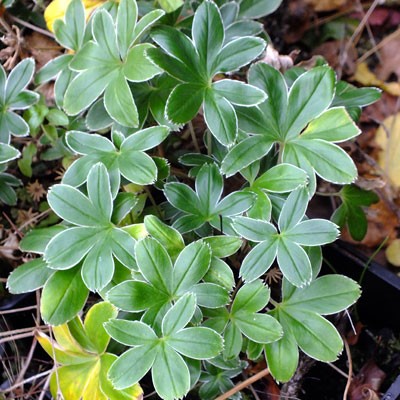
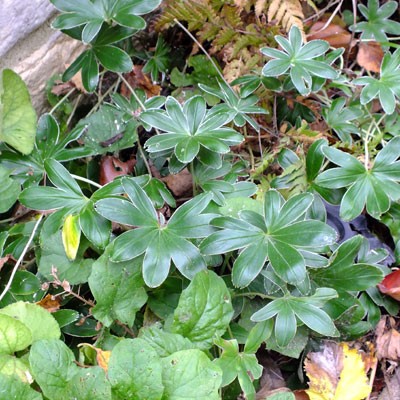
Potsize - 1L
A very neat, refined version of Ladies' Mantle with small neat foliage shaped like a rounded seven point star. The leaf edges are picked out in silvery hairs. The sprays of pale green flowers have distinctive calyces, lending the flowers a spherical texture. Smaller and less rambunctious than its cousin Alchemilla mollis but with similar charming flowers that make such a lovely foil to other flowers, both in the garden or in a vase. Easier to grow than the similar Alchemilla alpina, under whose name this is often sold, which really demands alpine conditions with perfect drainage.Links
Alchemilla in the Garden
-
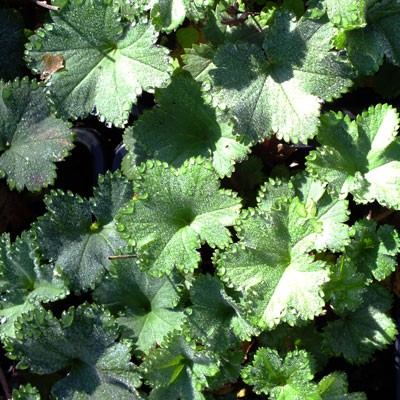


RHS AGM
Potsize - 1L
A smaller form of the otherwise similar Alchemilla mollis with beautiful scalloped, serrated edged foliage which often takes on a blueish-grey hue. Typical chartreuse sprays of flowers are produced in Summer on purply stems and act as a lovely foil to other blooms. Grows about 6 inches high and 8 inches wide and, apart from needing sun for at least part of the day, is very undemanding.Links
Alchemilla in the Garden
-

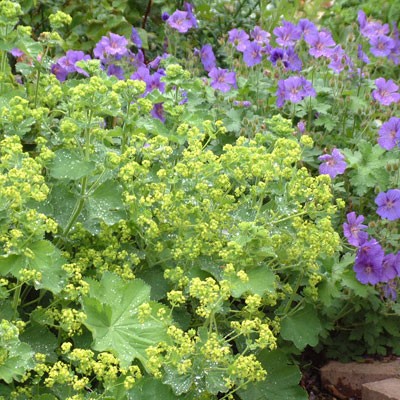
Potsize - 1L
Alchemilla mollis. Scalloped hairy leaves form a dense clump and are a delight when bejewelled with dew or raindrops. The flower heads are like a dense limey green gypsophila. A fantastic tough and rewarding plant that will grow happily in all but soggy sites, thriving in dry shade. It assorts remarkably well with so many other plants as well. The colour of the flowers of Alchemilla is derived from two rows of sepals, the flowers lack petals. Medieval alchemists believed the water droplets that collected in the centre of alchemilla leaves possessed magical and medicinal properties. The plant has a long tradition of being used to cure women's ailments and the plant was consequently named in dedication to the Virgin Mary. The leaves were seen as resembling a mantle (cloak). Alchemilla derives from the Arabic word 'alkimiya' = alchemy Discount of 25p per plant for quantities of 3 or overLinks
Alchemilla in the Garden
-


Potsize - 1L
3 warm coral-pink outer petals are kissed by just a hint of lipstick pink, giving a warm rosy glow. The innermost 3 petals have all the vibrancy of a tropical fish, being golden yellow with flecks of deepest beetroot guiding the bees to its rosy throat. A showy border plant thriving in moisture retentive, free draining rich soil in sun or part shade. Mulch well to ensure survival in harsh Winters. Compact mound 60-70cm. June to October. Bred in France by Ernst Turc for long flowering and good performance as a cut flower.Links
Botanical Style Photographs
-
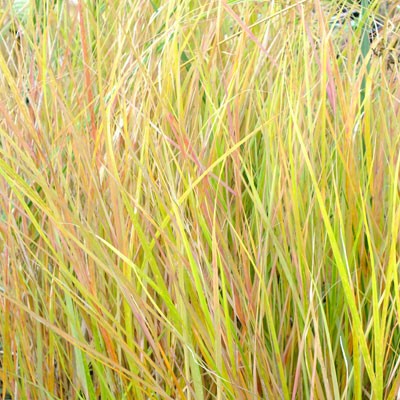
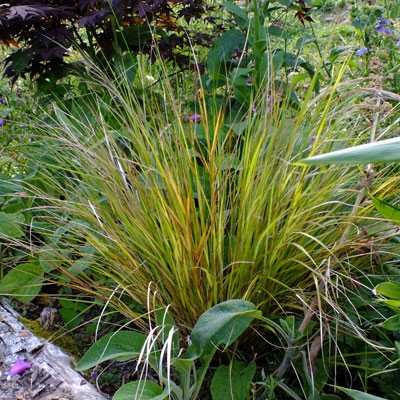
Potsize - 1L
A very distinctive grass, notable for the range of colour in the foliage which is striped in shades of orange and brown, more so as the season goes on and best when the plant is a little stressed. The flower heads are really airy , starting like a long delicate arching fly-swish and gradually branching into a very light cloud. -
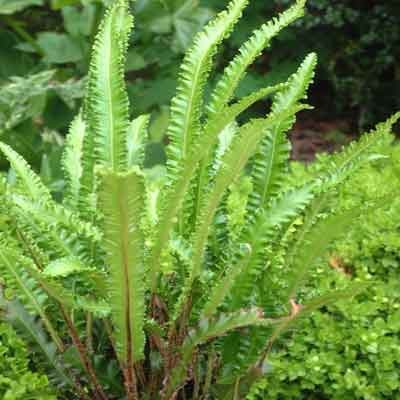
Potsize - 1L
Asplenium scolopendrium 'Angustatum'. a selected form of our native Hart's tongue fern with attractive narrow, bright green fronds, a shade darker than the species, with a crinkled undulating margin. 45cm 18'' . A lovely foil for other plants or as a contract to other ferns. For shade. Will tolerate quite dry conditions once fully established. Prefers a little lime.Discount of 25p per plant for quantities of 3 or overLinks
Ferns - Garden Pictures
Ferns for Moist Sites
Ferns for Dry Sites
Ferns - Deciduous or Evergreen
Botanical Style Photographs
-
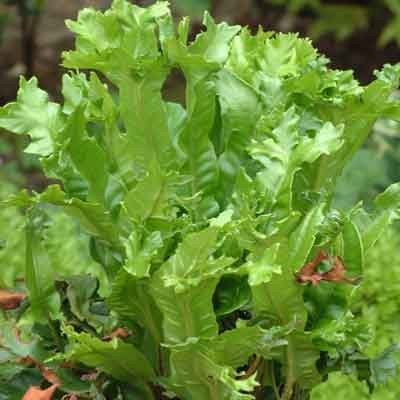
Potsize - 1L
Asplenium scolopendrium 'Cristatum'. The fronds of this variety are split numerous times at the tip so that the end of the frond resembles a frilly fan. The usual vase shape of the Hart's tongue fern is replaced by a more domed effect. Shorter than the species, usually less than 30cm. Best in semi shade. Will only take dry sites if well shaded and once well established. 45cm. prefers a little lime.Discount of 25p per plant for quantities of 3 or overLinks
Ferns - Garden Pictures
Ferns for Moist Sites
Ferns for Dry Sites
Ferns - Deciduous or Evergreen
Botanical Style Photographs
-
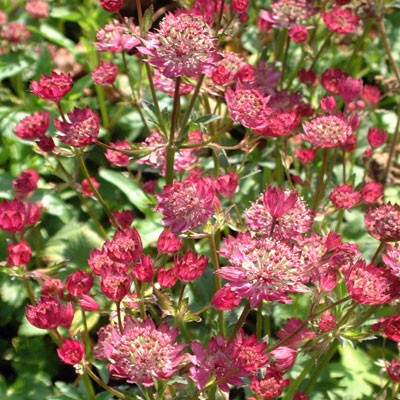
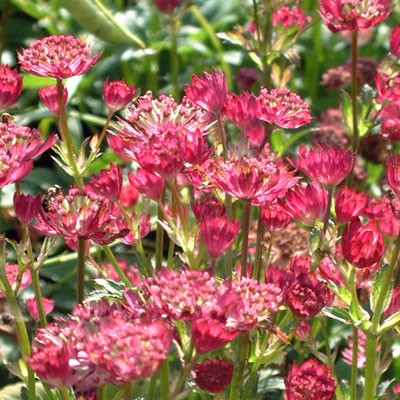
Potsize - 1L
A recently selected large flowered dark red masterwort. Tight clusters of maroon flowers are surrounded by beautiful ray florets. An interesting & beautiful plant happy in sun or part shade with some drainageLinks
Astrantia Compared
Astrantia in the Garden
Botanical Style Photographs
-
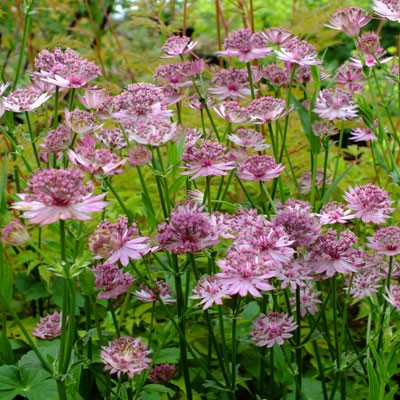
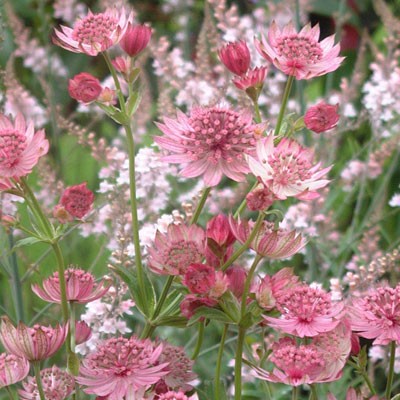
Potsize - 1L
Astrantia 'Roma'. Lovely mid pink cultivar of good constitution. The bracts form a shallow starry cup that is a shade lighter than the tight central pincushion of true flowers. 60cm. An interesting & beautiful plant Happy in sun or part shade with some drainageLinks
Astrantia Compared
Astrantia in the Garden
Botanical Style Photographs
-
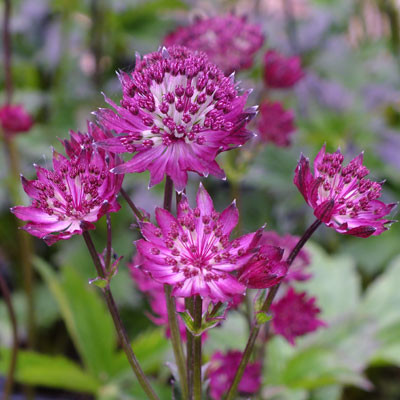
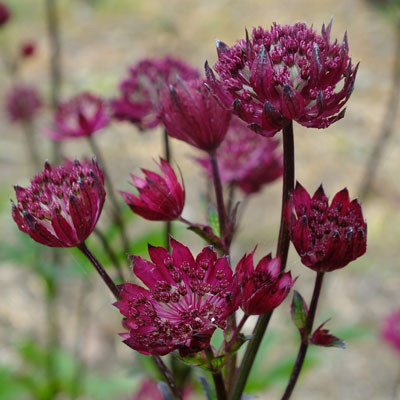
Potsize - 1L
We've seen it written that Astrantia 'Ruby Wedding' makes it inferior to some of the clonally propagated ones out there, but we've not found that the case at all. The ones we have are every bit as rich in colour as Ruby Wedding and Hadspen Blood. They don't have the dark staining leaves of the Gill Richardson Group, but for flower alone they are a lovely deep red with flowers of a very decent size. Ruby Wedding has its origins at the RHS Wisley where it was selected as a superior seedling in a sowing of Astrantia major subsp. major. Its bracts are of a good size and are strongly red to purple in hue. It is the parent of the seed strain known as Claret which may or may not live up to its parents reputation. It i svery similar to Hadspen Blood which has a similar bloodline but was selected by Nori Pope of Hadspen Gardens.Links
Astrantia Compared
Astrantia in the Garden
Botanical Style Photographs
-
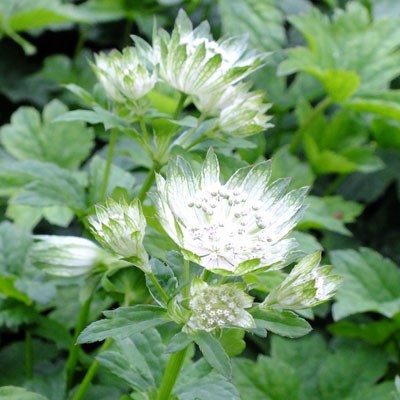
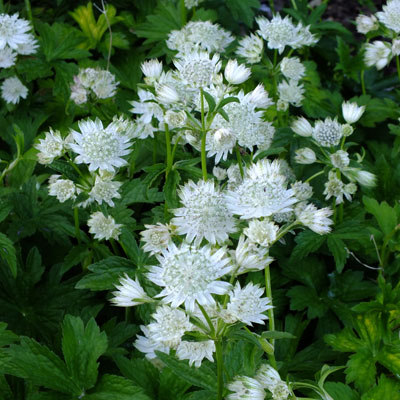
Potsize - 1L
A pure white, green-tipped, large flowered Astrantia from the 'Star' breeding program. We have examined this closely this year and it looks for all the world exactly like 'Shaggy', the excellent old variety selected by Margery Fish. It is a fine plant but we are as yet unsure why it merits its own name and PBR status.Links
Astrantia Compared
Astrantia in the Garden
Botanical Style Photographs
-
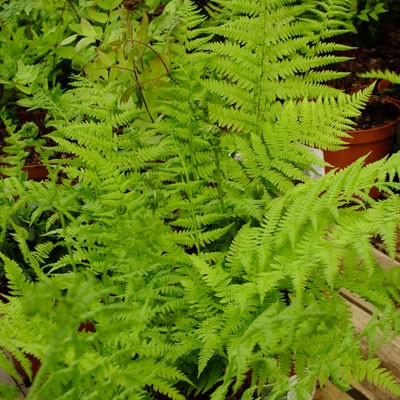
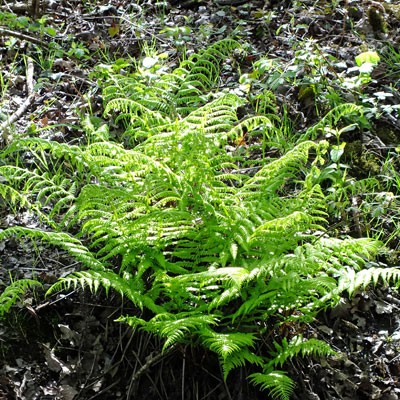
Potsize - 1L
This is the plain native form of Lady Fern, a plant that can be found throughout Britain growing in damp shady sites, but avoiding calcareous soils. It is an extremely hardy species and one that is quite variable from bipinnate to tripinnate sometimes. Whichever, it has a finer appearance than the Male fern and to my nose it is one of the 'ferniest smelling' of the ferns. It is fairly soon cut down with the onset of the frosts and is fully deciduous. Whilst a moist atmosphere is always an advantage and that coupled with a moist site will allow this fern to show of its best, once established they will actually tolerate quite dry sites, though with a cost on performance and leaf quality in dry spells.Discount of 25p per plant for quantities of 3 or overMore About Ferns
The Fern Order (Taxonomical List)
Botanical Style Photographs of Ferns
-
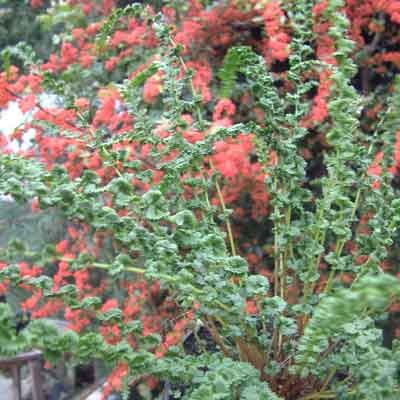
Potsize - 1L
Athyrium filix-femina 'Frizelliae'. Tatting fern. In this fascinating variant of our native lady fern the pinnae are reduced to small circular lobes all along the length of the frond. Height 15-25cm. Best in damp semi-shade, but can take drier sites than most Athyrium filix-femina varieties on account of it losing less water than fuller fronded varieties. Because each frond is essentially linear, this is a very distinctive variety, having more the outline of a grass than a fern. Discovered in County Wicklow by Mrs Frizell in 1857. Tatting is handmade lace.Discount of 25p per plant for quantities of 3 or overMore About Ferns
The Fern Order (Taxonomical List)
Botanical Style Photographs of Ferns
-
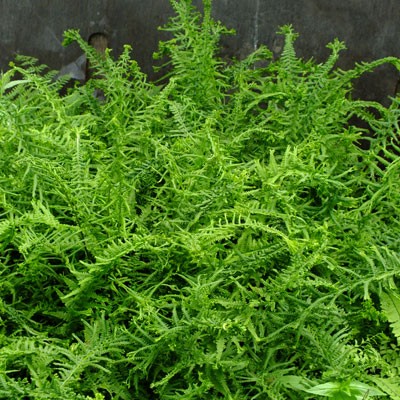
Potsize - 1L
This is the cruciate form of our native Lady fern. The leaves retain the lovely delicate nature of the species, but are distinguished in that alternate pinnae along the frond point either up or down from the plane of the leaf so that, were you to look down the length you could see a cross pattern. Often referred to as The Queen of the Ferns, it was a much treasured Victorian find. The tip of each pinna is also slightly crested which accentuates the overall frond outline. As with the native form, this is best in light shade with access to moisture at all times. grows to 90cm maybe a little more.Discount of 25p per plant for quantities of 3 or overMore About Ferns
The Fern Order (Taxonomical List)
Botanical Style Photographs of Ferns
-
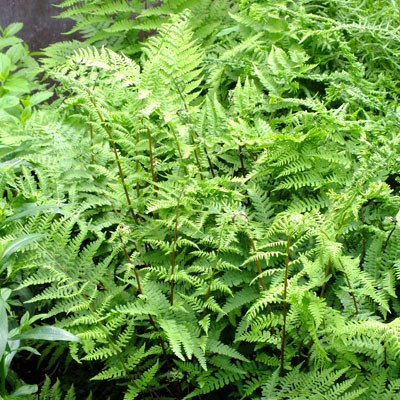
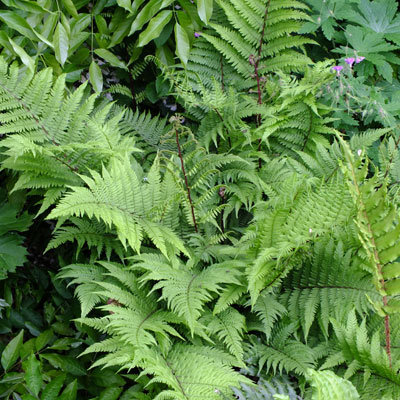

RHS AGM
Potsize - 1L
This is a selection of the North American form of our native Lady Fern which has stipes (frond stems) that are picked out in a rich ruby red. The full colouration is not apparent on young plants, but increases after plants have passed through their first frosty winter and then intensifies with age. Good nutrition will also intensify the colour. Overall the fronds are delicate in texture and posses that lovely 'ferny smell' when brushed. Needs constant access to moisture to grow at its best, achieving 90cm in height. Discovered in Vermont by John Lynch of the New England Wildflower Society.Discount of 25p per plant for quantities of 3 or overMore About Ferns
The Fern Order (Taxonomical List)
Botanical Style Photographs of Ferns
-
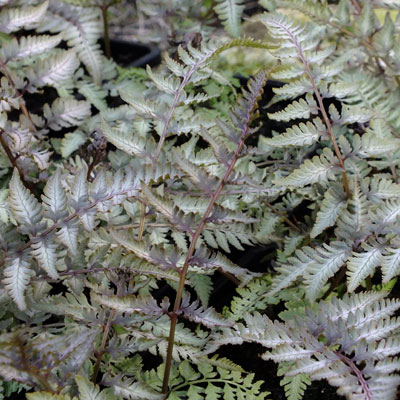
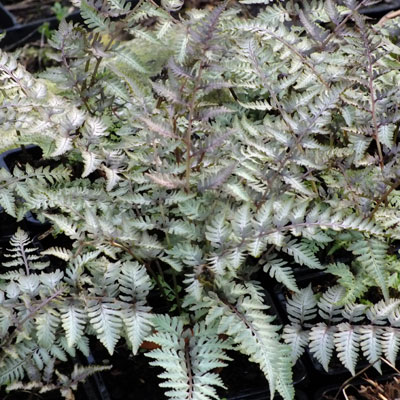
Potsize - 1L
Japanese Painted Fern. One of the many fine cultivars of this already lovely fern. Fronds are fine and delicate with a metallic silvery green sheen. Fronds are broad and grow fairly horizontally such that a plant will give good ground coverage when in leaf. A lovely fern worthy of a little care and a moist shady spot where it will prove most hardy. 45cm. DeciduousDiscount of 25p per plant for quantities of 3 or overMore About Ferns
The Fern Order (Taxonomical List)
Botanical Style Photographs of Ferns
-
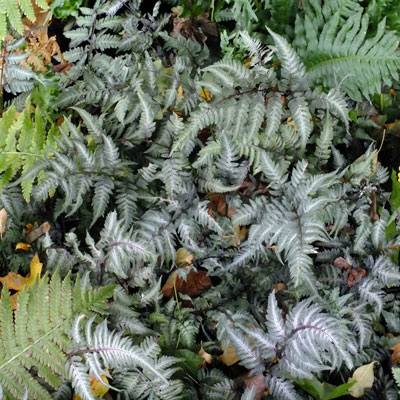
Potsize - 1L
Japanese Painted Fern. One of the many fine cultivars of this already lovely fern. Each frond begins the season green, ageing with a metallic silvery sheen which is further enhanced by rosy red etching and shading . Fronds are broad and grow fairly horizontally such that a plant will give good ground coverage when in leaf. A lovely fern worthy of a little care and a moist shady spot where it will prove most hardy. 45cm. DeciduousDiscount of 25p per plant for quantities of 3 or overMore About Ferns
The Fern Order (Taxonomical List)
Botanical Style Photographs of Ferns
-
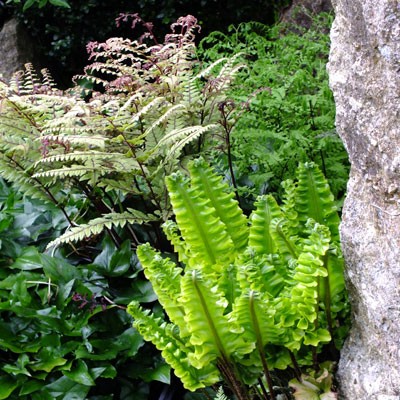
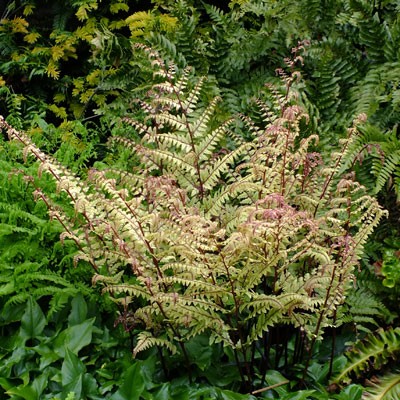
Potsize - 1L
Athyrium otophorum 'Okanum' is a very choice fern with striking colouration. The young fronds emerge a pale ochre with prominent maroon veining, giving the Spring plant far more the colours you expect of Autumn. It is especially striking with the light shining through the foliage. As spring progresses, the fronds assume a blue green tint. A lovely fern to brighten a moist dark corner. 60cm. Retains its fronds longer than most female ferns. Deciduous, needs moisture.Discount of 25p per plant for quantities of 3 or overMore About Ferns
The Fern Order (Taxonomical List)
Botanical Style Photographs of Ferns
-
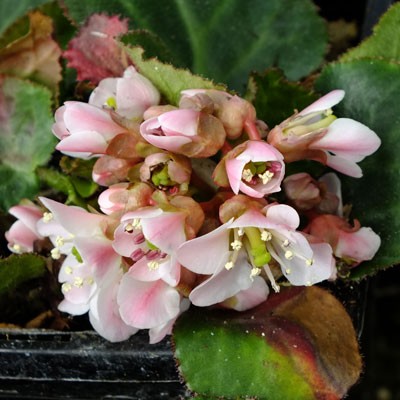
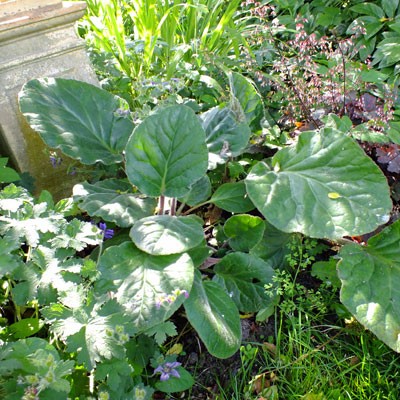
Potsize - 1L
Bergenia ciliata. The leaves of this choice species are large- up to 30cm across, well rounded and covered in tiny hairs. It makes a large clump, but considerably less dense than most bergenias. The flowers are pink, held erect and slightly fragrant. Slightly more tender than the more robust species and deserving of a spot with some shelter, especially for the flowers. Foliage will die back somewhat in winter. Leaves colour red in Autumn. Native of Afghanistan and Tibet. Prefers cool moist shade.Links
Bergenia Compared
Botanical Style Photographs
-
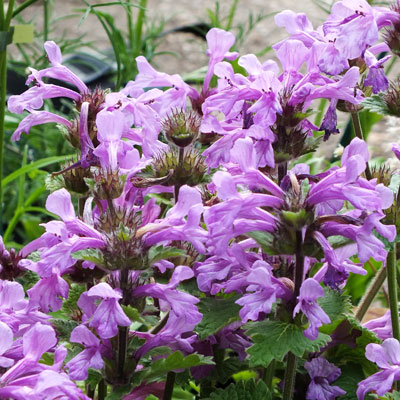


Bee Friendly
Potsize - 1L
Whilst the heart shaped leaves make good muted green ground cover, it is the flowers are remarkable. In shape and colour they are very like the heads of betony, if a little paler, but they are borne on short stalks and are of a large size quite out of proportion with expectations. A first rate plant for the front of the border. No where near as rampant as its cousin, Stachys lanata. Plant in sun for good flowering. 30cm Discount of 25p per plant for quantities of 3 or over -

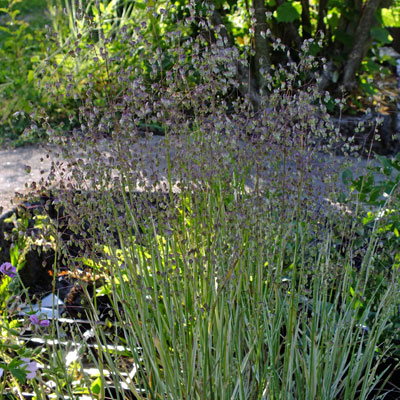
Potsize - 1L
A pretty quaking grass with tidy mounds of soft glaucous leaves with handsome white edges and striping. In Summer, dainty wands of little dancing lockets are produced which sway in the breeze. Green-white at first and often tinged with pink, the seed heads become golden with age. Semi-evergreen clumps of leaves. Not a very long lived plant but careful regular division can extend its life. Seedlings do not come true. 50-70cm in flower, 30cm in leaf.Discount of 25p per plant for quantities of 3 or over -
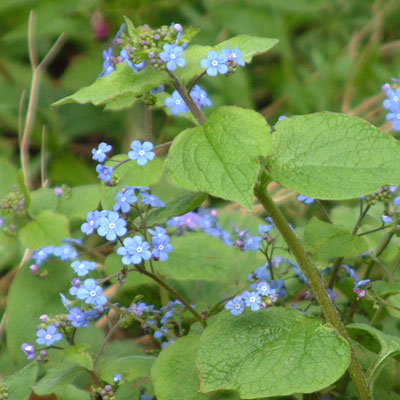
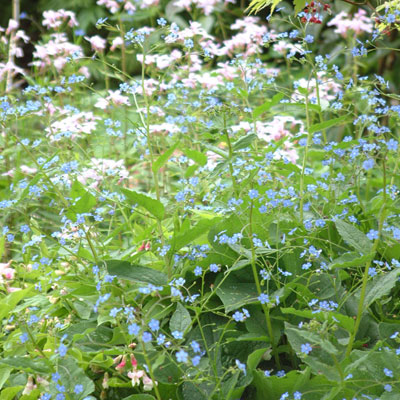
Potsize - 1L
Siberian Bugloss. A brilliant perennial which grows well in dry shady places, but will excel in most reasonable positions. Large heart-shaped felty green leaves make a stout clump topped in Spring with a cloud of tiny forget-me-not flowers. Hardy and reliable and one of those plants that ought to find a place in every garden. 30-45cmDiscount of 25p per plant for quantities of 3 or overLinks
Brunnera Compared
Botanical Style Photographs
-

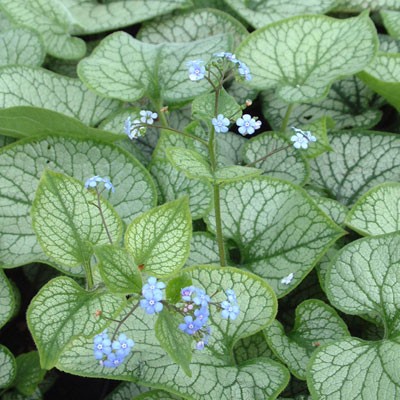

RHS AGM
Potsize - 1L
Brunnera macrophylla 'Jack Frost'. Coarsely hairy, heart-shaped leaves are heavily silvered and picked out by dark green margins and veins, making fascinating patterns not unlike an intricate cathedral window. A picture from Spring to Autumn especially when given shade and adequate moisture to prevent scorching in high Summer. The Spring display is further enhanced by an airy cloud of icy-blue forget-me-nots on stems decorated with smaller but similarly marked leaves. 50cmLinks
Brunnera Compared
Botanical Style Photographs
-
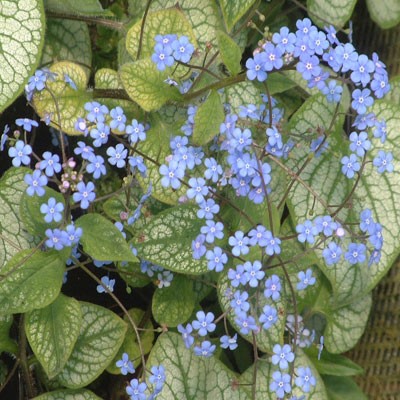
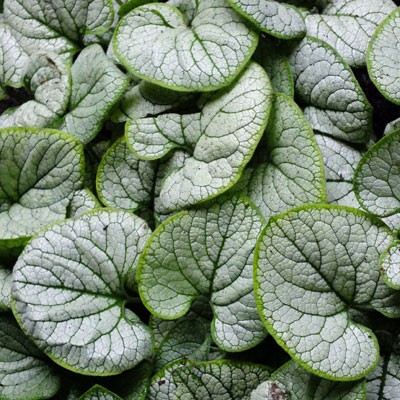
Potsize - 1L
Brunnera macrophylla 'Silver Heart'. A new introduction (2012) by Spilsbergen-Willemsen from the Netherlands. Superficially like a more silvered version of the popular Jack Frost, but generally considered to be a tougher more sun resistant variety on account of the thicker character of the leaves, which can also grow larger in size. Coarsely hairy, heart-shaped leaves are heavily silvered and picked out by dark green margins and veins, making fascinating patterns not unlike an intricate cathedral window. A picture from Spring to Autumn especially when given shade and adequate moisture to prevent scorching in high Summer. The Spring display is further enhanced by an airy cloud of icy-blue forget-me-nots on stems decorated with smaller but similarly marked leaves. 50cm plusLinks
Brunnera Compared
Botanical Style Photographs
-
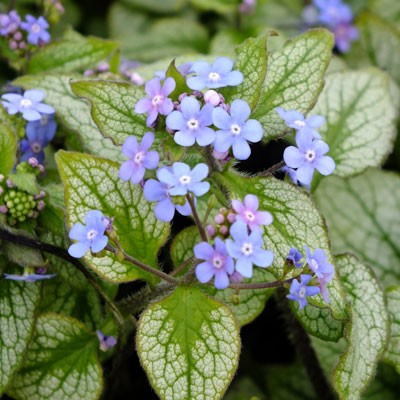
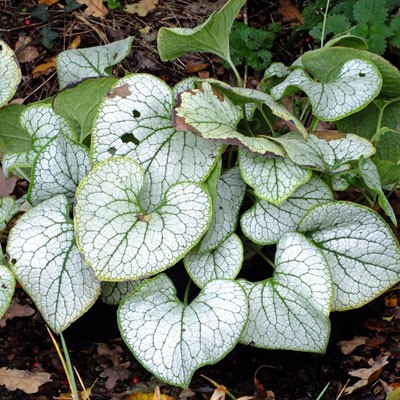
Potsize - 1L
Very similar to the ever popular Brunnera 'Jack Frost' except that it is a little whiter and has an elongated pointed tip to the leaf. Leaves are a lovely silver with the veins picked out in green forming a dense mound in any situation that is out of direct sun. Clouds of blue forget-me-not flowers in Spring.Links
Brunnera Compared
Botanical Style Photographs
-

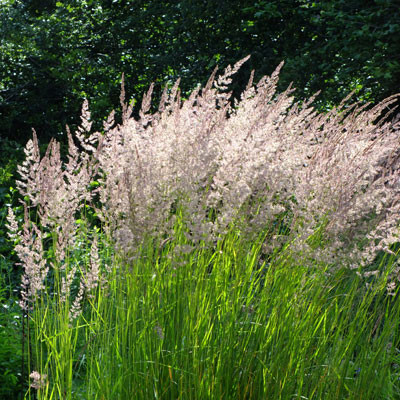
Potsize - 1L
Feather Reed Grass. This fine variety was named after the distinguished German nurseryman Karl Foerster (1874-1970) who selected and introduced it. It is a sterile hybrid (C.arundinacea x C.epigejos) and forms a narrow column, 60cm high in leaf and 150cm plus in flower. The flower spikes are narrow feathery plumes, purpley green to start, ageing a lovely golden shade in Autumn and persisting well into the Winter. It will tolerate a wide range of soils, including heavy clay and compacted soils and whilst it prefers a sunny drier site, it will tolerate a wet site well. The first grass to win Perennial Plant of the Year, which it did in 2001Discount of 25p per plant for quantities of 3 or over -
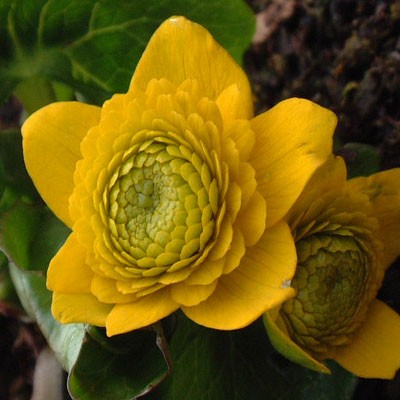
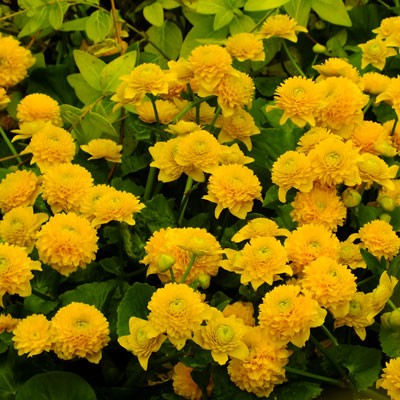

Bee Friendly
Potsize - 1L
As Marsh Marigolds go this one is relatively compact in growth, shorter in all its parts. However it is the flowers that are the chief attraction. They start off looking like a normal Marsh Marigold with the tightest anemone centre you could imagine. Then, as the flowers age, the centre petals grow out until you have a full blown miniature pom-pom dahlia of a flower in rich glowing gold. 30cm spread. Marsh Marigolds are amongst the first flowers of Spring, flowering throughout the month of April.Discount of 25p per plant for quantities of 3 or over -


- Butterfly Friendly
- Bee Friendly
Potsize - 1L
Cephalaria gigantea . Giant Yellow Scabious. A magnificent sight in early summer with its large mound of roughly hairy, pale green, deeply pinnatifid foliage and 6ft branching stems generously furnished with 3in pale lemon flowers which sway in the slightest breeze. You can use Cephalaria at the back of any scheme or alternatively further forward as the flowering stems are not dense, allowing you to see through to sights beyond.Discount of 25p per plant for quantities of 3 or overLinks
Scabious Compared
Botanical Style Photographs (Scabiosa)
Botanical Style Photographs (Succisa / Succisella)
-
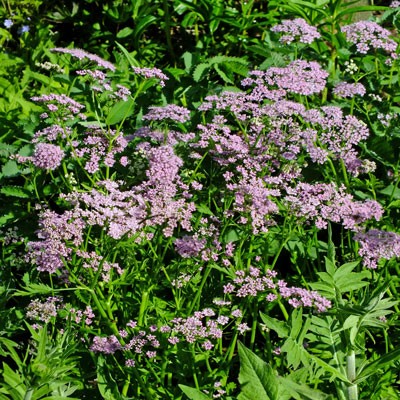

Potsize - 1L
Chaerophyllum hirsutum 'Roseum'. A stout Umbellifer with quite a distinctive colouring. The leaves are soft and hairy in a similar manner to Sweet Cicely and apple green in colour. The flowers are sugary pink in close umbels, tighter than a Cow Parsley. If happy it can make a substantial clump, 2ft or more in leaf alone. Best with moisture. This plant naturally exists in a spectrum of forms from a barely blush to a strong sugar pink. This form is at the strong end of this spectrum. There are some things that fundamentally split marriages, deep unbridgeable divides that can never be healed. This plant is one of those - Dawn thinks it's just lovely, whereas I think the pink is just a bit pink for the oh so green leaves. Maybe its a girl-boy thing. I'm sure we'll get over it.Links
Botanical Style Photographs
-

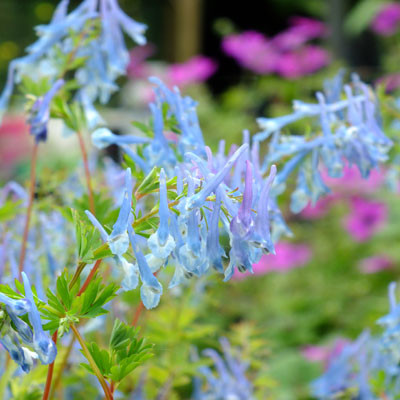
Potsize - 1L
A cross between Corydalis fleuosa and Corydalis omeniana from Ian Young's garden in Aberdeen. Vigorous clumps of limey, chartreusy-green juicy fern-like foliage over which come the strongly scented sky-blue flowers. Like Corydalis elata, but smaller and colouring only very slightly in the stems. Wintergreen and very hardy if grown in a moisture retentive soil which is not over wet and doesn't dry out in the Summer. Divide every three years to maintain vigour and encourage the best flowering. Flowers from Spring until June. 30cmLinks
Corydalis Compared

















































